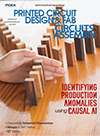News
News
A Clean Start
Published: 25 September 2008
by Chrys Shea
Our columnist gets a wakeup call on the tenacity of Pb-free residues.
I just spent a day with the Washington, DC area SMTA chapter. Their annual event includes a tabletop vendor show and a full day of technical sessions. It was in the Cleaning Roundtable session that I became enlightened. Speaking on the topic of removing no-clean flux residues, Mike Bixenman of Kyzen explained formulations of older, SnPb products tended to use more natural rosins, whereas newer, Pb-free products use more synthetic resins to help withstand the hotter processing conditions. These newer, polymer-based resins can be more difficult to clean. Not impossible to clean, just a little more “stubborn.”
For those of you wondering about the difference between a rosin and a resin, that’s actually a lesson I learned a few years ago from Sanju Arora at Cookson Electronics. A paper we wrote on flux selection defined the relationship between the two material sets this way: “Rosins are a subset of a larger chemical family of resins. Rosins are substances that occur naturally (in pine trees and other plant material) and have been extracted and refined. Resins are similar compounds that are either completely synthesized, or are highly processed rosins.”1 (Incidentally, I don’t actually know the point at which a rosin becomes so processed that it must be reclassified as a resin; that’s one of many finer points of chemistry that escapes me.)
Also during the session, Mizra Arshad from Zestron shared experimental results from cleaning tests performed on SnPb and Pb-free solder paste residues under low-standoff components. Several variables were tested, and in each comparison, the Pb-free residues required a higher setting than did the SnPb: higher chemical concentration, slower process time, more agitation, higher impingement velocity or faster flow rate. Not all the highest settings were needed in combination to achieve good cleaning. He noted some possible tradeoffs, such as increased agitation permitting faster belt speeds or lower chemical concentrations. Regardless of main effects or interactions, however, Pb-free residues were consistently harder to remove than those of SnPb. Again, not impossible, but characteristically more difficult.
As devices get smaller, spaces get closer and frequencies run higher, cleaning will continue to become more important. During the SnPb era, our industry eliminated CFC-based cleaning from assembly processing. Although some sectors transitioned to no-clean processes more quickly or directly than others, the number of PWBs that were cleaned steadily dwindled over the years. Nearly two decades into the no-clean era, cleaning was typically reserved only for special products – those that needed extra long-term reliability or high performance in harsh environments. Now that we’ve made the Pb-free transition, cleaning may actually start gaining in popularity. I think within a few years we will clean a higher percentage of assemblies than we do today. My prediction is not related directly to the alloy change; it’s based purely on densification of the circuitry. Miniaturization efforts slowed for a few years while Pb-free technology was breaking in, and now we’re seeing the next generation of packaging coming onto the market. Soon we’ll be assembling devices that only no-clean pastes are capable of printing, and some of these devices will have no tolerance for even the most insulative of flux residues. Cleaning those no-clean residues will be necessary. And it will be more difficult. Not impossible, but definitely more difficult. Now I’m convinced.
Reference
- Chrys Shea, Sanju Arora and Steve Brown, “Selection of Wave Soldering Fluxes for Pb-Free Assembly,” Circuits Assembly, March 2007.
Chrys Shea has 20 years’ experience in electronics manufacturing and is founder of Shea Engineering; chrys@sheaengineering.com.
Press Releases
- INSPECTIS AB ‘Makes it a Meal’ with Series U50s Advanced Kit
- Silicon Mountain Contract Services Enhances SMT Capabilities with New HELLER Reflow Oven
- Libra Industries Launches In-House High-Precision Underfill Capabilities
- HyRel Technologies and NJ MET Announce Strategic Collaboration for Integrated Component Services







